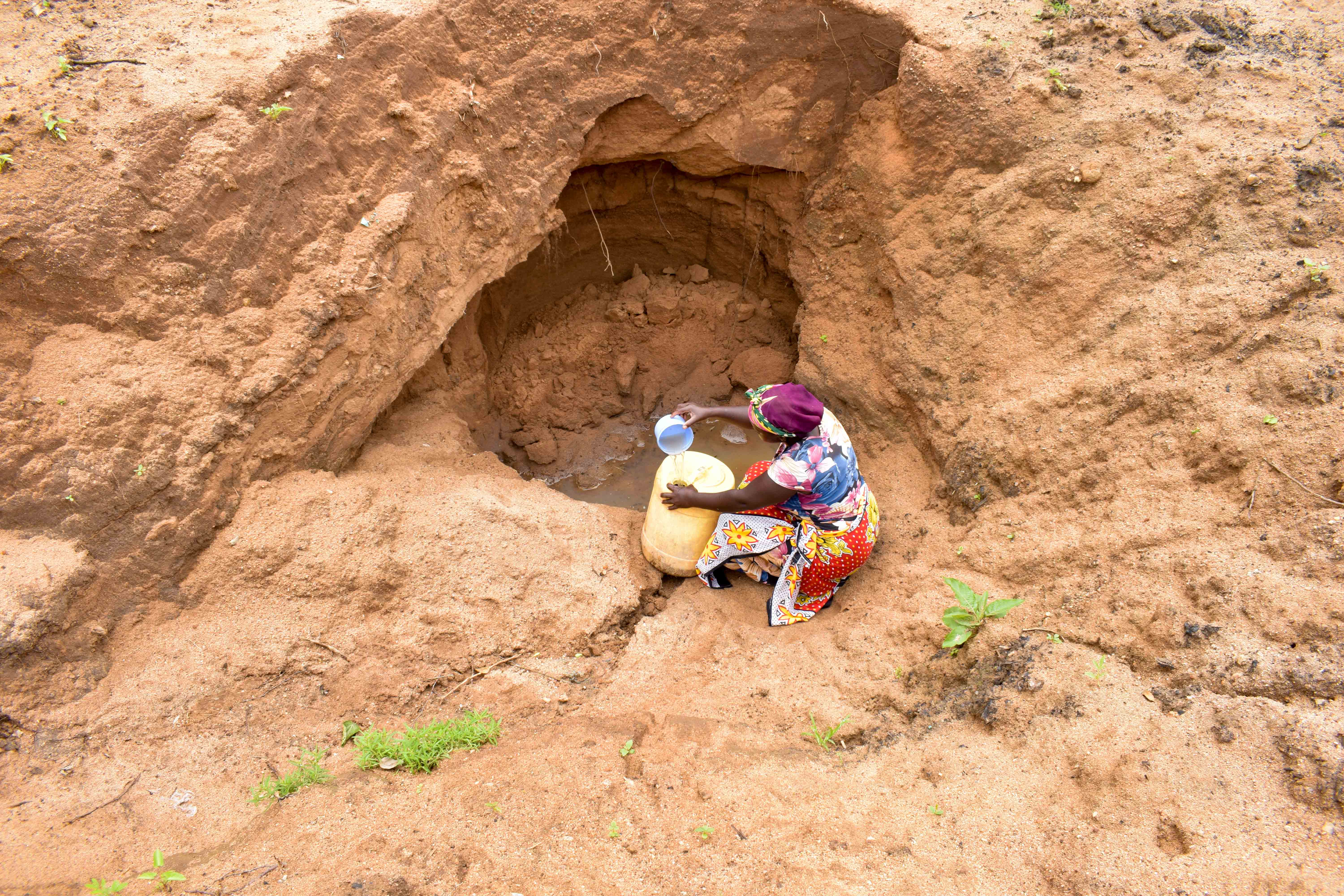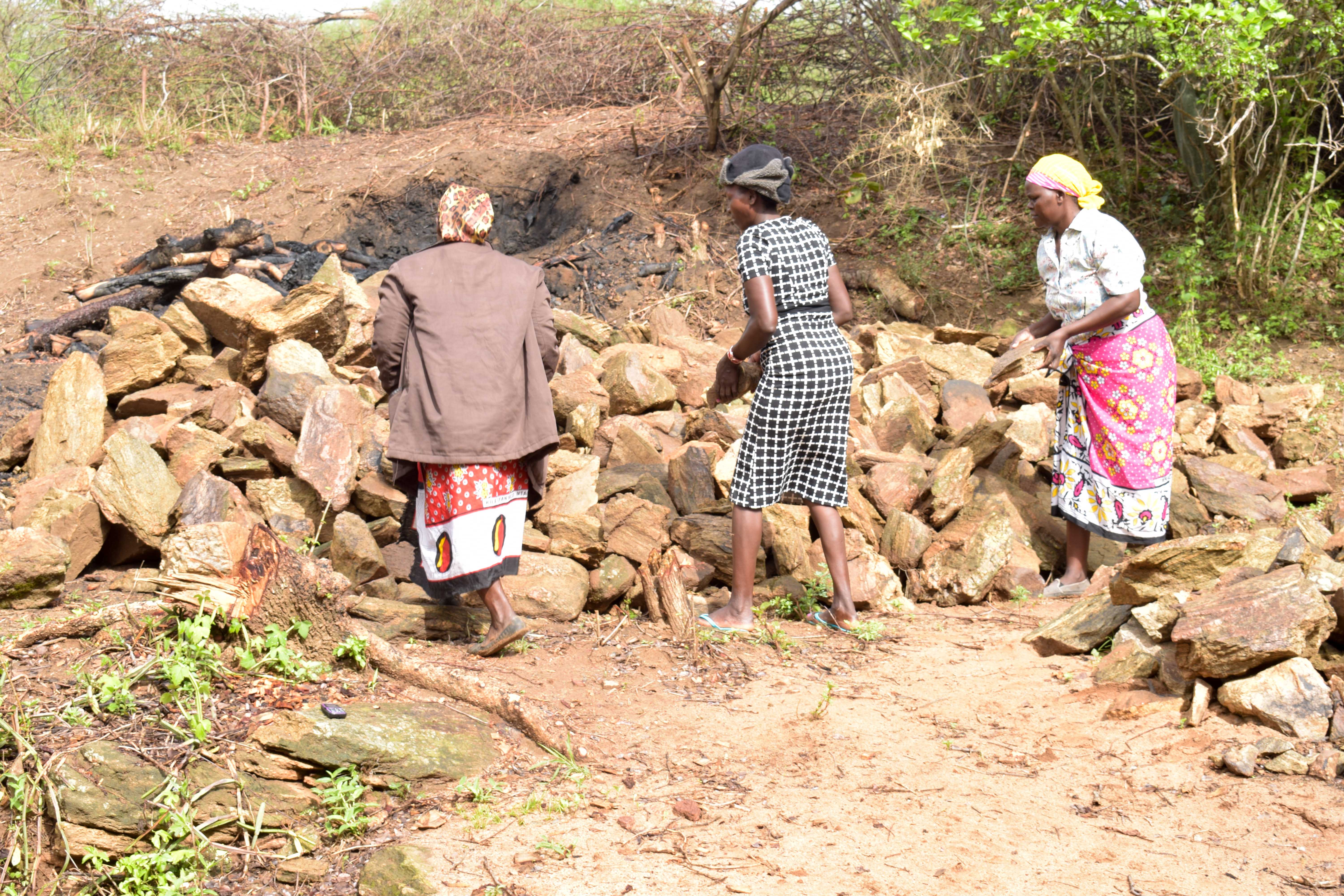Project Updates
July, 2020: Through Their Eyes: COVID-19 Chronicles with Tabitha Mutheke
This post is part of a new series by The Water Project meant to highlight the perspectives and experiences of the people we serve and how the COVID-19 pandemic is impacting them. We invite you to read more of their stories here.
"Having a sand dam and shallow well in our locality are helpful to us in this time of a global pandemic. It requires communities have access to water and practice good hygiene," said Tabitha Mutheke, a 46-year-old mother of 5 children we met during a recent visit to Kathamba Ngii Community.
"The wells have been providing unlimited clean water access to all of us, which is making it possible for regular hand washing all the time as a way of protecting ourselves from the coronavirus."

Tabitha Mutheke
The Water Project continues to support communities and water points through the COVID-19 pandemic. We are training community members on steps to prevent the spread of the virus, and what people can do if someone gets sick. We are also speaking with community members to hear how their lives are affected by the pandemic.
While in Kathamba Ngii, we spoke with Tabitha. She said she is not working right now since the markets are closed. Normally, she sells clothing at the weekly markets in the area. Also, all of her children are home because the Kenyan schools were closed in April and will remain closed through the end of 2020.

Tabitha Mutheke participates in social distancing exercise.
"Access to enough basic food items has changed because I am no longer earning income through my normal business activities. I am no longer able to afford enough food items for my children, and we are mostly surviving on poor diets through the available food items from my small farm," she shared.
An estimated 1 million Kenyans are out of work since the start of the pandemic - many of whom are small business owners and market sellers like Tabitha. Fortunately, people living here, including Tabitha, have Access to a reliable water source through the well and sand dam they constructed last year. The water is helping keep Tabitha and her family safe. And it provides water that she uses for her farm to grow food that she can feed her family and potentially sell to other community members.

"Access to water in this time of coronavirus is easy since the water is found right in the village. This has helped limit interactions with people from far areas while also providing water round the clock," she said.
We continue to monitor and support the well and dam in Kathamba Ngii so that the people living here do not have to worry about water access, especially during a time of increased stress. Go here to learn more about how The Water Project is responding to the COVID-19 pandemic.

May, 2020: COVID-19 Prevention Training Update at Kathamba Ngii Community
Our teams are working on the frontlines of the COVID-19 pandemic. Join us in our fight against the virus while maintaining access to clean, reliable water.

We are carrying out awareness and prevention trainings on the virus in every community we serve. Very often, our teams are the first (and only) to bring news and information of the virus to rural communities like Kathamba Ngii, Kenya.
We trained community members on the symptoms, transmission routes, and prevention of COVID-19.
Due to public gathering concerns, we worked with trusted community leaders to gather a select group of community members who would then relay the information learned to the rest of their family and friends.
We covered essential hygiene lessons:
- Demonstrations on how to build a simple handwashing station
- Proper handwashing technique
- The importance of using soap and clean water for handwashing
- Cleaning and disinfecting commonly touched surfaces including at the water point.

We covered COVID-19-specific guidance in line with national and international standards:
- Information on the symptoms and transmission routes of COVID-19
- What social distancing is and how to practice it
- How to cough into an elbow
- Alternative ways to greet people without handshakes, fist bumps, etc.
- How to make and properly wear a facemask.

During training, we installed a new handwashing station with soap near the community’s water point.
Due to the rampant spread of misinformation about COVID-19, we also dedicated time to a question and answer session to help debunk rumors about the disease and provide extra information where needed.
Water access, sanitation, and hygiene are at the crux of disease prevention. You can directly support our work on the frontlines of COVID-19 prevention in all of the communities we serve while maintaining their access to safe, clean, and reliable water.

June, 2019: Kathamba Ngii Community Sand Dam Complete
Kathamba Ngii Community, Kenya now has a new source of water thanks to your donation. A new dam was constructed on the riverbed, which will build up sand to raise the water table and naturally filter water. Recent rains have helped the dam begin to build up sand and store water. With this water, the surrounding landscape will become lush and fertile.
It could take up to three years of rain (because sometimes it only rains once a year!) for this sand dam to reach maximum capacity. Sand dam construction was undertaken simultaneously with the construction of a hand-dug well that will give community members a safe method of drawing water. As the sand dam matures and stores more sand, a supply of water will be available for drinking from the adjacent hand-dug well. To see that hand-dug well, click here.
Construction for this dam was a success!

We worked with the Kwa Mbunza Self-Help Group for this project. The members and their families contributed materials and physical labor to complete the projects. In addition, they were trained on various skills such as bookkeeping, financial management, project management, and group dynamics/governance.
"This water project will go a long way towards improving water access in our village and in this locality at large," said Mwikali Maluki.
"It was not an easy task. With determination and commitment, we have made it since we all know the importance and relevance of this water point to the community."
When an issue arises in relation to the water project, the group members are equipped with the necessary skills to rectify the problem and ensure it works appropriately. However, if the issue is beyond their capabilities, they can contact their field officer to assist them.
Sand Dam Construction Process
The community members collected all of the local materials like rocks and sand that were required for successful completion of the dam. They also provided unskilled labor to support our artisans. The collection of raw construction materials takes longer than the actual construction. For a large sand dam, materials collection could take up to four months.

While we delivered more expensive materials like cement, lumber, and work tools, community members gathered sand, stones, and water.
Siting and technical designs were drawn and presented to the Water Resources Management Authority and a survey sent to the National Environment Management Authority for approval before construction started. Once approved, we established a firm bedrock at the base of the sand dam wall. In the absence of good bedrock, excavation is done up to a depth at which the technical team is satisfied that the ground is firm enough to stop seepage.

Then mortar (a mixture of sand, cement, and water) is mixed and heaped into the foundation. Rocks are heaped into the mortar once there is enough to hold. Barbed wire and twisted bar are used to reinforce the mixture. Once the foundation is complete, a skeleton of timber is built to hold the sludge and rocks up above ground level. The process is then repeated until a sufficient height, width and length are built up. The vertical timber beams are dismantled and the dam is left to cure.

After 34 days of construction, the final dam is 33.9 meters long, 3.4 meters high and took 380 bags of cement to build.
Renewed Knowledge
The field officer in charge of Waita region, Austin Mumo, mobilized the group members for the hygiene and sanitation training. This is the second project with the self-help group so the focus of the training was to both refresh lessons learned and focus on areas that are in need of improvement. Austin met with the group and agreed on a suitable date. All community members were invited for the training.

The attendance on the days of the training was as expected. Even a village elder and a community health worker attended. All members present showed attention to the details of the training. They also participated actively by asking questions and providing their personal experiences.
A gap was identified during a follow-up visit where it was observed that only five members out of the 15 members were treating their drinking water. Due to this gap, the members were taken through various methods of water treatment and water hygiene.
After the training, the members were very happy to learn how to treat their drinking water and promised to embrace the practice.

"We have also learned about how we get sick by drinking contaminated water and from today we will treat our drinking water," said Kasyoka Muthui, a member of the group.
One member was randomly picked to demonstrate on how to wash hands. He then demonstrated on the procedure and got some corrections from the rest of the members. Seeing the members correct each other was very interesting. The members were also taken through the critical moments to wash hands.
"The training has reminded us on many things which we had forgotten. We will have good health and our families will be free from sicknesses," Mwikali Kimwele said.
"The soapmaking training will help us to improve our hygiene and sanitation. We will no longer buy poor quality soap from the market since we will be making our own quality soap."

The training was successful and there were no challenges. The members of this group are committed to improving their hygiene and sanitation. This training will help them to achieve changes in hygiene and sanitation.
Thank You for making all of this possible.

April, 2019: Kathamba Ngii Community Sand Dam Project Underway
People living in Kathamba Ngii currently have to walk a very long way to find water, and that water isn’t even clean. Thanks to your generosity, we are working to build a sand dam that will bring water closer to home for hundreds of people.
Get to know this community by reading the introduction and pictures we’ve posted, and read more about this water, sanitation, and hygiene project and how it works. We look forward to reaching out again when we have more news!




 Sand Dam
Sand Dam
 Rehabilitation Project
Rehabilitation Project







































